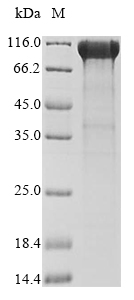To prepare this Recombinant Human CSPG4 protein, the recombinant DNA was required, which was generated by fusing the CSPG4 gene with N-terminal 10xHis tag and C-terminal Myc tag sequence. Once the recombinant DNA was amplified and purified, a protein expression system, Mammalian cell, was needed for this CSPG4 protein production. After purification, a premium CSPG4 recombinant proteinwas obtained. According to SDS-PAGE, its purity turns out to be 85%+.
CSPG4 (also known as MCSP) is an encoding gene that provides an instruction in making protein named chondroitin sulfate proteoglycan 4 (short name is CSPG4). CSPG4 protein, a member of the chondroitin sulfate proteoglycan family, consists of core protein and chondroitin sulfate side chains. It presents on normal human tissues and plays an important role in cell growth, adhesion, and migration. CSPG4 was first found to be highly expressed in melanoma, so it is also known as melanoma proteoglycan (MPG). It is a phylogenetically conserved tumour antigen that plays an important biological role in human melanoma. Currently, it is used as a marker to diagnose forms with unusual characteristics, such as desmoplastic melanoma.






